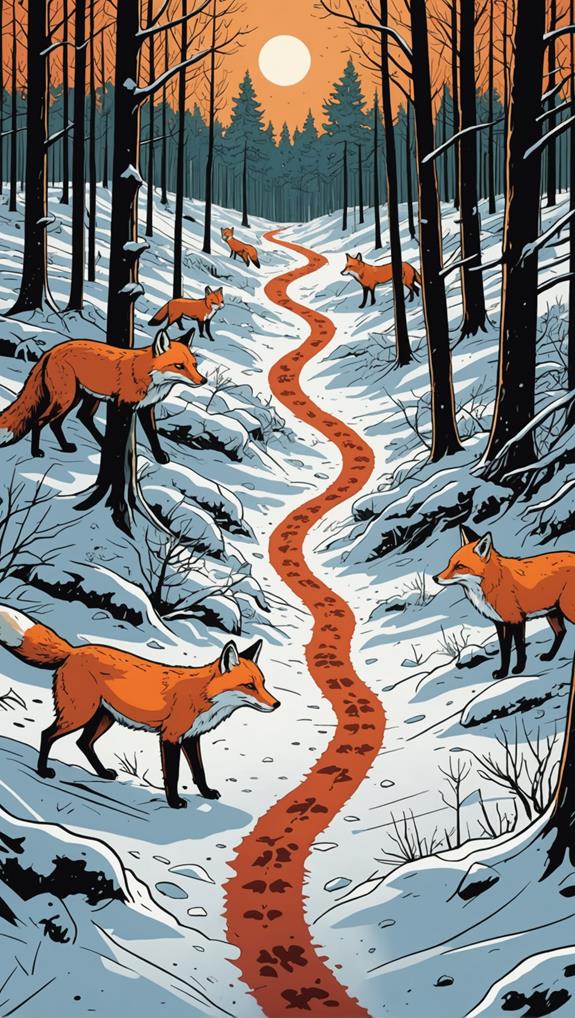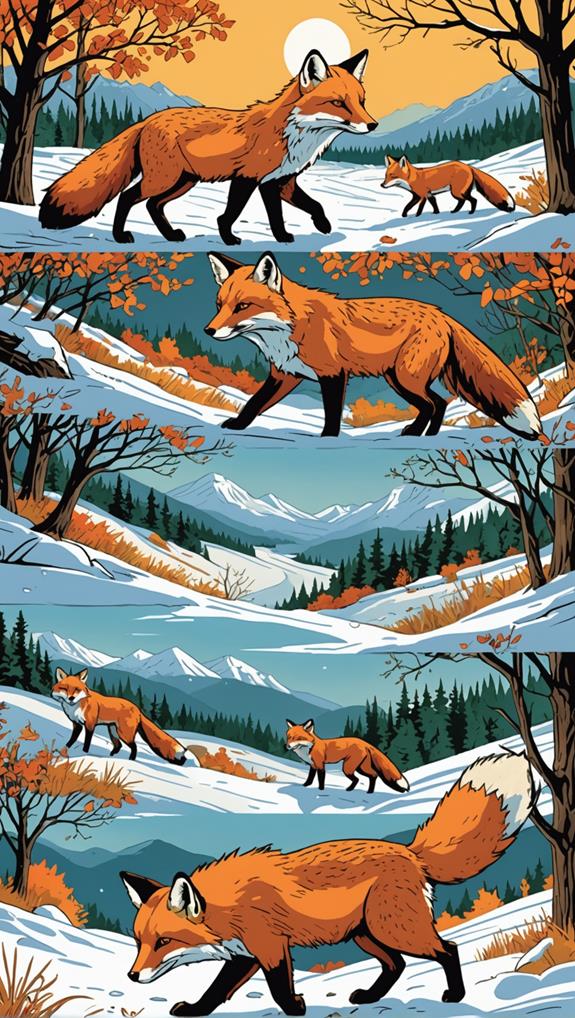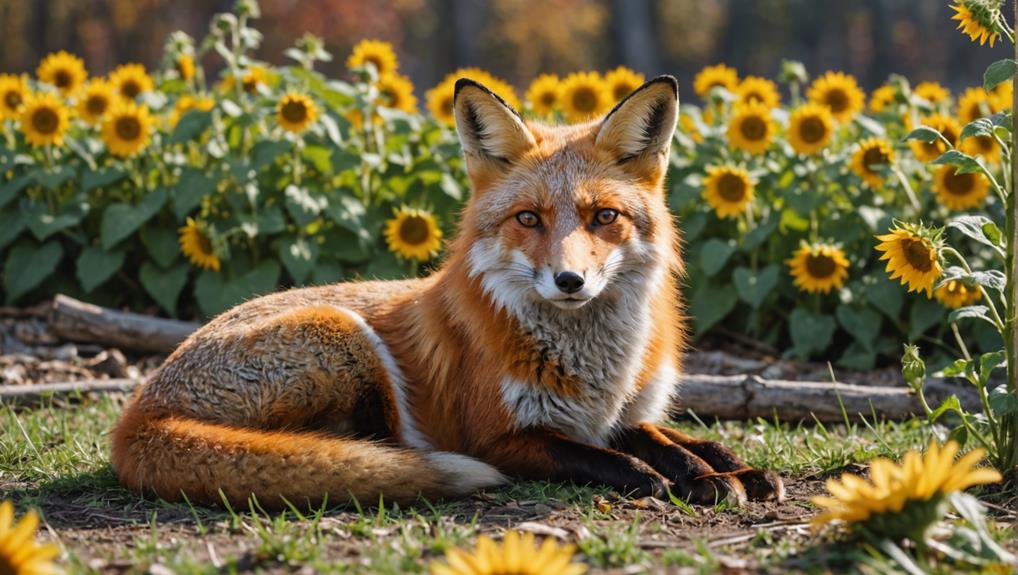As you step into the winter landscape, the frosty air is alive with secrets, whispers of a hidden world where red foxes weave a complex social tapestry. But have you ever wondered how the changing seasons influence their behavior, their interactions, and their very social fabric? It's a question that has long fascinated scientists, and the answers are more intriguing than you might expect. For instance, did you know that the warmth of spring and summer brings these cunning creatures closer together, only to have them drift apart when the cold winds of winter blow? The story of how seasonal changes shape the social lives of red foxes is one of adaptation, survival, and surprising twists – and it's a story that's just beginning to unfold.
Contents
- 1 Social Structure and Group Dynamics
- 2 Seasonal Variation in Contact Rates
- 3 Extraterritorial Movements and Gene Flow
- 4 Ecological and Social Implications
- 5 Temporal Patterns and Interaction Rates
- 6 Behavioral Characteristics of Movements
- 7 Network Connectivity Insights
- 8 Frequently Asked Questions
- 9 Final Thoughts
Social Structure and Group Dynamics
In the intricate world of red fox social dynamics, a complex web of relationships emerges at higher population densities, where groups can swell to include up to ten adults, with a surprisingly balanced mix of males and females.
As you delve into the social structure of these fascinating creatures, you'll notice that their group dynamics are influenced by various factors, including seasonal variations. Within these groups, social interactions are a daily occurrence, with encounter rates averaging 1-1.5 times per day at food patches. This frequent contact reinforces group cohesion, which is vital for the group's stability throughout the year.
Interestingly, female foxes play a crucial role in maintaining this cohesion, highlighting the significance of sex and social status in their interactions. Red foxes have been found to thrive in urban environments, where they exhibit remarkable adaptability, and their flexible diet allows them to adapt to seasonal food availability.
The complexity of their social structure is further reflected in the varying network connectivity among red foxes, which differs seasonally and by territory. By understanding these dynamics, you'll gain a deeper appreciation for the intricate social lives of red foxes.
Seasonal Variation in Contact Rates
As you explore the social dynamics of red foxes, you'll discover that their contact rates fluctuate significantly across the seasons.
They've a natural rhythm, with peaks in spring and summer, and dips in winter. This seasonal variation is closely tied to food availability, which is abundant in mixed landscapes such as woodlands and farmland urban adaptation and population growth.
When food is plentiful, especially during spring and summer, red foxes encounter each other more frequently – about 1-1.5 times per day at food patches. This increase in encounter rates contributes to stronger social bonds, which are essential for relationship longevity.
Interestingly, males have the lowest contact rates during winter, while subordinate females and dominant males peak in contact rates during spring. This highlights the complex social structure of red foxes, where individuals adapt their behavior according to the season and food availability.
Extraterritorial Movements and Gene Flow

During their lifetime, a red fox may cover hundreds of miles, but it's the extraterritorial movements that reveal their remarkable adaptability. These movements are crucial for the species' survival, as they facilitate gene flow and shape population dynamics.
You see, red foxes exhibit distinct extraterritorial movements during dispersal and reproductive searching. Males, in particular, travel greater distances in search of mating opportunities, often characterized by faster speeds compared to territorial movements.
Notably, the Arctic fox's compact body structure is an adaptation that allows it to thrive in harsh environments, and understanding such adaptations can inform our approach to managing red fox populations.
Radiotracking data from a study in Bristol, UK, highlighted these behavioral differences, showing that dispersal movements contribute significantly to gene flow and population dynamics by enhancing genetic diversity and reducing inbreeding risks.
Understanding these extraterritorial movements is vital for modeling disease transmission dynamics in urban red fox populations, ultimately informing effective wildlife management and conservation strategies.
Ecological and Social Implications
Beyond their impressive extraterritorial movements, red foxes' social dynamics are equally fascinating, and seasonal changes play a significant role in shaping their ecological and social behaviors.
You see, seasonal variations in social interaction rates among red foxes indicate that contact frequency peaks in spring and summer when food availability is higher and reproductive activities are more intense. This means that during these seasons, red foxes are more likely to interact with each other, strengthening their social bonds and community ties.
In contrast, during winter, male red foxes exhibit a significant reduction in contact rates, suggesting that social behaviors and interactions are influenced by seasonal resource scarcity and environmental factors.
The connection between food availability and social cohesion is evident, as encounters among foxes increase across all seasons, highlighting the importance of food resources in facilitating social interactions.
This, in turn, impacts the structure and stability of fox social networks, influencing adaptive social strategies that may affect gene flow, disease transmission, and overall population dynamics.
Temporal Patterns and Interaction Rates

As you explore the temporal patterns and interaction rates of red foxes, you'll notice that their extraterritorial forays are timed strategically, often coinciding with optimal movement performance strategies.
You'll see that these strategies are crucial in determining interaction rates with territory holders, which can make or break their chances of securing valuable resources.
Timing of Extraterritorial Forays
When venturing outside their territory, red foxes exhibit distinct temporal patterns and interaction rates, influenced by seasonal fluctuations in food availability and reproductive behaviors.
You'll notice that extraterritorial forays peak in spring and summer, coinciding with increased social interactions during these times. This makes sense, given the importance of resource acquisition and mating opportunities. In fact, the average encounter rate with conspecifics during high-quality food patches is around 13%, highlighting the role of resource availability in driving social interactions and temporal behaviors.
Interestingly, dominant males tend to reduce their contact rates during winter, while subordinate females and dominant males show increased interaction in spring, emphasizing seasonal variation in social dynamics.
Long-term social relationships among territory residents are maintained through consistent companionships, with significant changes in encounter rates based on seasonal influences and food provisioning dynamics.
Movement Performance Strategies
You'll find that red foxes' movement performance strategies are closely tied to their temporal patterns and interaction rates. As you delve into their social behavior, you'll notice significant seasonal variations in their interactions and contact rates, peaking in spring and summer. This strategic planning in their movement performance is influenced by environmental factors, such as food availability, which correlates with increased contact rates across all seasons.
Interestingly, males exhibit reduced contact rates during winter, while subordinate females show increased interactions, highlighting seasonal social dynamics.
When it comes to territorial dynamics, red foxes exhibit distinct temporal strategies in their social structure. They avoid territory holders during dispersal and reproductive movements, reflecting a clever approach to resource abundance.
Interaction Rates With Holders
One key aspect of red fox behavior involves their interaction rates with holders, which are closely tied to temporal patterns and social dynamics. As you explore the world of red foxes, you'll notice that their social connectivity is deeply connected to the seasons.
For instance, encounter frequencies increase during spring and summer due to higher food availability, leading to more frequent social interactions.
Here are three key takeaways about red fox interaction rates:
- Seasonal peaks: Interaction rates spike in the spring and summer, with subordinate females exhibiting higher contact rates during this time.
- Resource areas: Red foxes gather at high-quality resource areas, where they engage in frequent social interactions, with average encounter rates reaching 1-1.5 times per day.
- Nighttime socializing: Longer meetings occur before midnight, particularly in the spring, suggesting strategic social behaviors related to resource availability.
These findings highlight the significant impact of seasonal variation on social dynamics and territory exploration behaviors.
Behavioral Characteristics of Movements
During the course of their seasonal movements, red foxes exhibit distinct behavioral characteristics that set dispersal and reproductive movements apart from standard territorial movements.
You'll notice that reproductive movements cover greater distances and feature more rapid speeds compared to dispersal movements. When juvenile red foxes disperse, they typically follow straighter paths while actively avoiding encounters with territorial adults to minimize conflict.
Both dispersal and reproductive movements occur at higher speeds than standard territorial movements, reflecting the urgency and purpose behind these extraterritorial actions.
Males, in particular, demonstrate considerable movement patterns during the reproductive phase as they seek mating opportunities, consistently traveling across urban and exurban environments.
Interestingly, analysis of turning angles shows that dispersal movements are characterized by fewer direction changes and increased directness compared to the more complex routes taken by resident territorial adults.
These behavioral characteristics reveal the adaptability of red foxes in response to environmental conditions, highlighting their remarkable ability to thrive in various social and ecological contexts.
Network Connectivity Insights

As red foxes navigate their seasonal movements, they also exhibit complex social behaviors that shape their network connectivity. You might wonder, what does this mean for their social lives? Well, researchers found that network connectivity among urban red fox populations varies significantly across seasons. The density of their social interactions fluctuates, ranging from 0.11 to 1 (unweighted) and 0.02 to 0.59 (weighted). This suggests that their social behaviors are dynamic and influenced by the time of year.
Here are three key takeaways about red fox network connectivity:
- Food patch visits matter: Encounter rates during these visits peak at 1 to 1.5 times per day, especially during spring and summer when high-quality food is abundant. This boosts their connection rates.
- Disassortment supports diversity: Network structures display disassortment, meaning foxes mix freely, regardless of sex or social status. This enhances genetic diversity and promotes social cohesion within the group.
- Territory identities shape networks: Longitudinal data analysis reveals that specific territory identities influence global network connectivity, accounting for 16-42% of changes across seasons. This highlights the importance of territory in shaping their social networks.
These insights offer a fascinating glimpse into the social lives of red foxes, revealing the intricate dynamics that govern their relationships and behaviors.
Frequently Asked Questions
What Is the Social Behavior of the Red Fox?
You observe a red fox family in a rural area, where they exhibit complex social behavior, marked by territorial marking, coordinated hunting strategies, and vocal communication, showcasing their group dynamics, play behavior, and food sharing, with dedicated parental care.
How Do Foxes Adapt to Changing Seasons?
You witness foxes adapting to changing seasons by modifying their foraging strategies, shelter selection, and mating habits based on food availability, while strengthening social bonds through vocal communication, play behavior, and territory marking to thrive in varied habitats.
What Is the Behavior of a Fox in the Winter?
As you observe a fox in winter, you'll notice it's all about survival: it's solitary winter foraging, denning in sheltered spots, adapting hunting techniques, regulating body temperature, and minimizing social interactions to conserve energy amidst food scarcity, all while employing clever survival strategies.
What Is the Social Structure of a Fox?
As you delve into the world of foxes, you'll find their social structure is a intricate tapestry, woven with threads of territorial disputes, mating rituals, and parental care, where pack dynamics, communication methods, and hunting strategies intersect, revealing complex social hierarchies and scent marking.
Final Thoughts
As you've seen, the social lives of red foxes are quite the rollercoaster ride! Their behavior changes with the seasons, from cozying up in spring to dispersing in winter. But what's the ultimate takeaway? Can we really call them social butterflies – or should we say, social foxes? In all seriousness, understanding these seasonal shifts can help us better conserve and appreciate these cunning creatures. By recognizing their dynamic social bonds, we can work to protect their populations and the ecosystems they inhabit.














